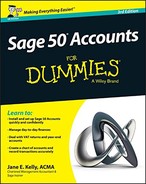Book Description
The easy way to come to grips with Sage 50 Accounts
Written by a Sage 50 Accounts expert and packed with step-by-step instructions, this hands-on, accessible guide is the easiest way to master this popular small business accounting software. Walking you through every aspect of setting up and using Sage 50 Accounts—from installing software to running VAT returns and producing year-end accounts—Sage 50 Accounts For Dummies offers easy-to-follow guidance on the quickest way to complete tasks and customise Sage to suit your specific business needs.
Recommended by 90% of accountants, Sage 50 Accounts is Europe's best-known small business accounting package. Now completely updated to reflect the latest version of Sage 50 Accounts, this friendly guide takes the hassle out of working with the software. In no time, you'll be navigating your way around the new Sage 50 Accounts interface, making sense of the latest changes to backups, and confidently taking control of your business' finances—freeing you up to spend your time managing other areas of your business.
Reflects the latest changes in the 2015 edition of Sage 50 Accounts software
Shows you how to set up and use Sage 50 Accounts with minimal fuss
Provides helpful screenshots to help you every step of the way
Offers guidance on going mobile with the Sage 50 app
Whether you're new to Sage 50 Accounts or just need to get up and running on the newest software, this no-nonsense guide makes it easy.
Table of Contents
- Cover Page
- Title Page
- Copyright
- Contents at a Glance
- Table of Contents
- Introduction
- Part I: Getting Started with Sage 50 Accounts
- Part II: Looking into Day-to-Day Functions
- Part III: Functions for Plus and Professional Users
- Part IV: Running Monthly, Quarterly and Annual Routines
- Part V: Using Reports
- Chapter 18: Running Monthly Reports
- Chapter 19: Tackling the Complicated Stuff
- Chapter 20: Running Key Reports
- Checking Activity through the Nominal Codes
- Looking into Supplier Activity
- Tracking Customer Activity
- Checking Numbers with Supplier Daybook Reports
- Finding the Customers Who Owe You
- Paying Attention to Your Creditors
- Handling Unreconciled Bank Transactions
- Doing a Monthly Breakdown of Profit and Loss
- Ranking Your Top Customers
- Chapter 21: Going Mobile
- Part VI: The Part of Tens
- Chapter 22: Ten (Okay, Eleven) Funky Functions
- Browsing for Help with F1
- Calculating Stuff with F2
- Accessing an Edit Item Line for Invoicing with F3
- Finding Multiple Functions with F4
- Calculating Currency or Checking Spelling with F5
- Copying with F6
- Inserting a Line with F7
- Deleting a Line with F8
- Calculating Net Amounts with F9
- Launching Windows with F11
- Opening Report Designer with F12
- Chapter 23: Ten (Plus One) Wizards to Conjure Up in Sage
- Creating a New Customer Account
- Setting Up a New Supplier
- Initiating a New Nominal Account
- Creating a New Bank Account
- Launching a New Product
- Starting Up a New Project
- Helping Out at Month-End: Opening/Closing Stock
- Fuelling Up: Scale Charges
- Saving Time: Global Changes
- Handling Currencies: Foreign Bank Revaluation
- Keeping Others in the Loop: Accountant Link
- Chapter 22: Ten (Okay, Eleven) Funky Functions
- Index
